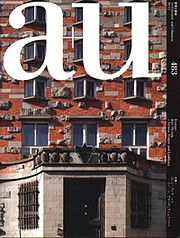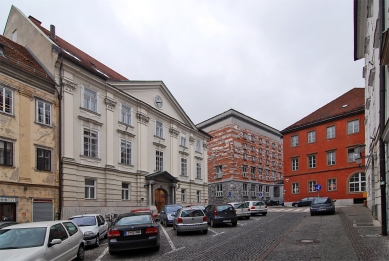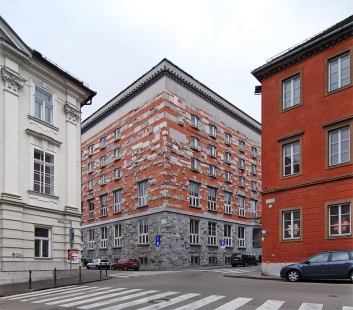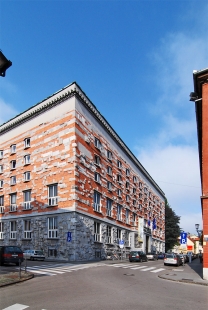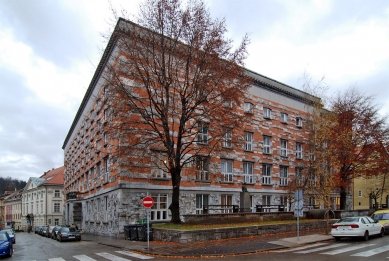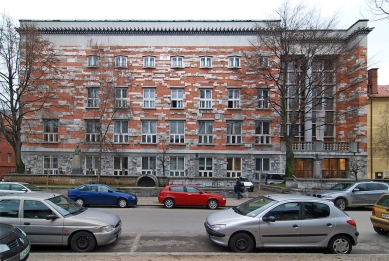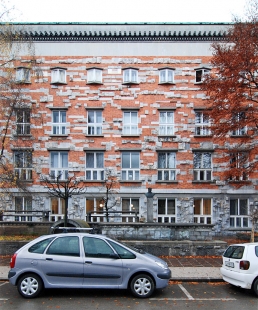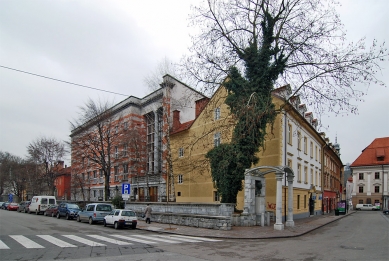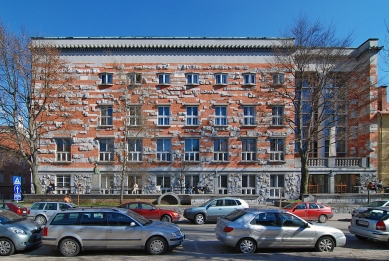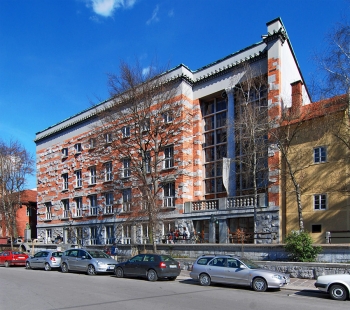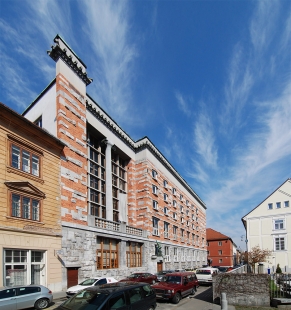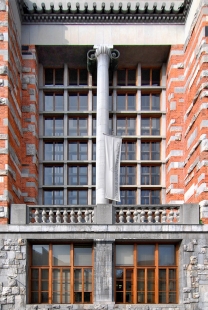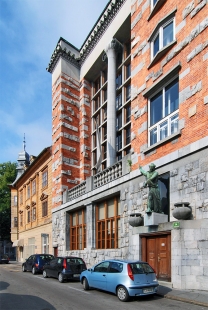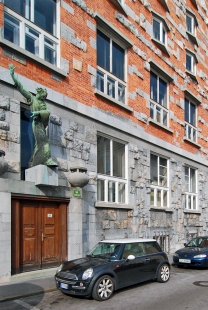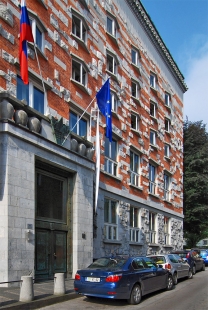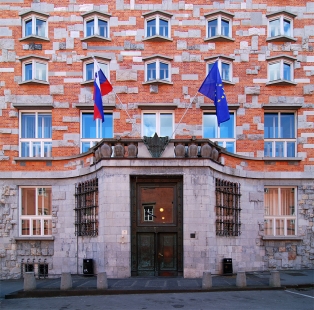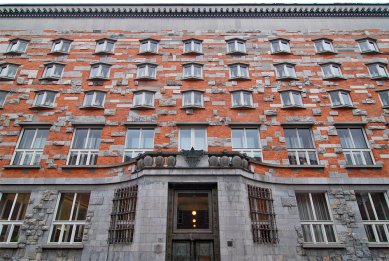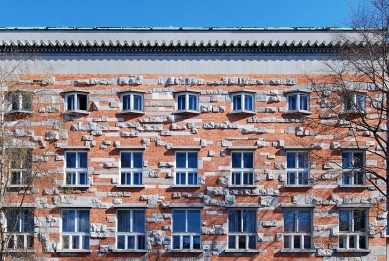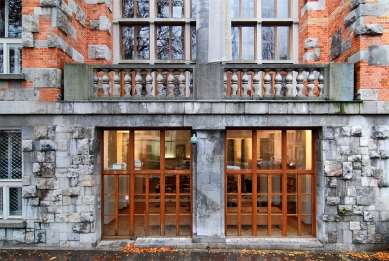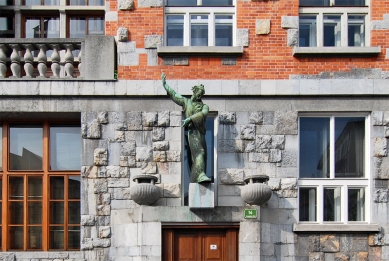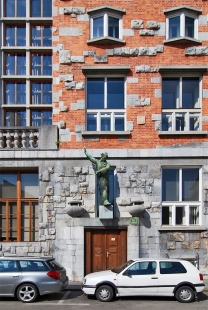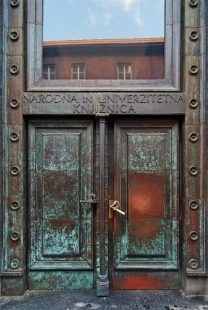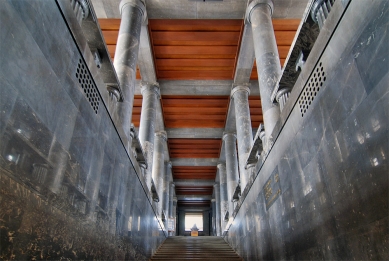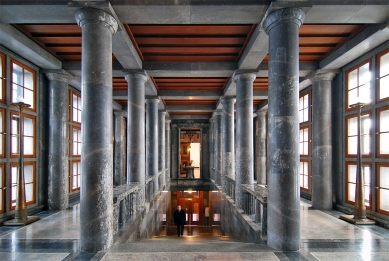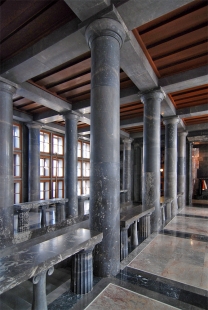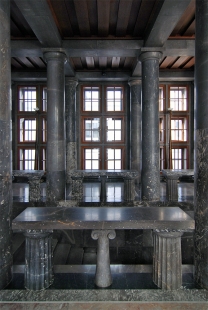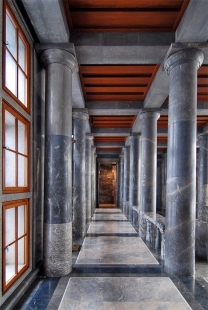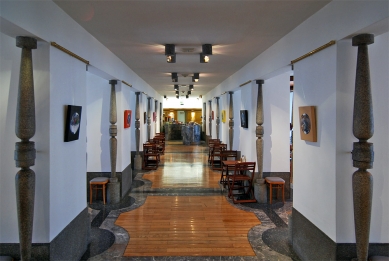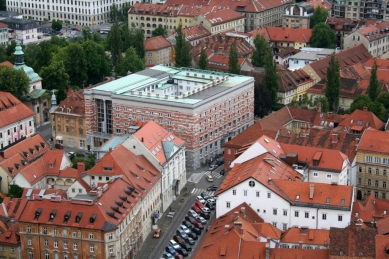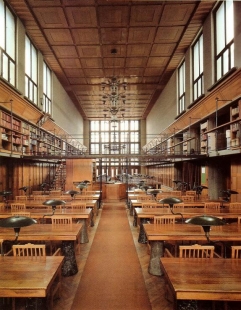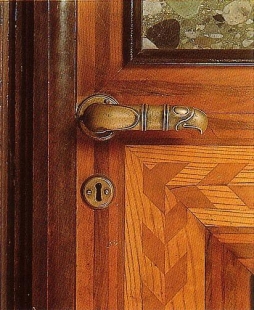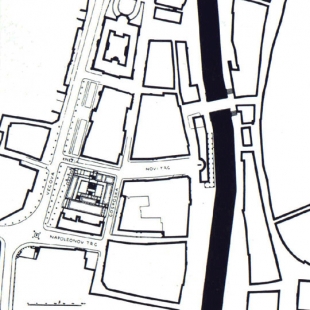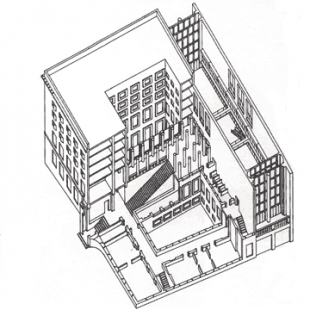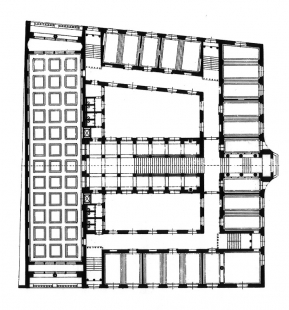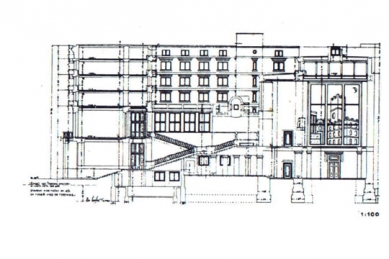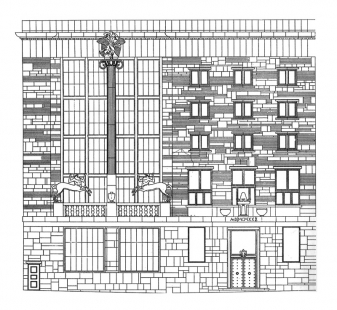
Slovenian National and University Library
National and University Library

The image of Ljubljana is complemented by dozens of Plečnik's interventions, ranging from large urban projects to intimate urban furniture, yet one building deserves special attention. The university library stands in the very center along the tranquil axis of Vegova street, flanked by a number of other educational buildings. The library, due to its uniqueness, is a bearer of identity, a reflection of the city's history, and literally a classic work of “Plečnik's Ljubljana“.
The difficult inception is evidenced by the fact that alongside Plečnik's project, which was commissioned directly by the university already at the turn of 1930/31, a functionalist design by Ivan Vurnik also sought favor. Vurnik, who defended the ornate “national style” until the late 1920s, began to advocate for purist forms in architecture after returning from Paris under the influence of Le Corbusier. Vurnik's counter-proposal received far greater acclaim from the international audience, which was then swept away by waves of new artistic movements; however, the realization of the library was entrusted to Plečnik, who significantly revised the final plans before the construction work began in 1936. Plečnik conceived the building as a 'temple of human education and wisdom essential for the healthy development of the nation and its independence.' Furthermore, the building was to honor the city even if it ceased to serve its original purpose.
The outer dimensions were adapted by Plečnik from the previous Renaissance building of the former Aueršperský palace, which was destroyed during the earthquake in 1895. The resulting mass, including the height of the cornice, was primarily intended to fill the gap left by the demolished palace, and only in the subsequent plan address the operation of the library and the issue of where to place more than a million volumes of books. Plečnik also drew from the design of the University Library in Vienna from 1910 by his teacher Otto Wagner. The library's outer shell is made of bricks and stone from the southern Slovenian village of Podpeč (podpeški apnec), but also stones from the princely palace and Roman walls that were uncovered during the foundation digging.
The National and University Library (NUK) is undoubtedly one of the key monuments of “Plečnik's Ljubljana,” visibly revealing the author's passion for monumentality, which was created from valuable materials and elevating impressiveness. This is especially evident in the main staircase clad in dark marble. Visitors continue from the softly lit entrance hall into the impressive foyer and from there into the 'light of knowledge and enlightenment' of the main reading room with a ten-meter high ceiling. An interesting feature in the wood-paneled reading room is the railing made from gas pipes with brass fittings. The rough construction was completed in 1941, but due to war damage, the interior furnishing was delayed until 1947.
“In every capital, there is usually one charismatic building that is a symbol and bearer of the identity of that place. Such buildings can reveal much about history and politics, innovations or obstructions, character and soul, typology and mentality, etc. This relates to a certain coherent attitude that allowed the uniqueness of the object. Looking back, we see examples of buildings similar to Plečnik's university library: The Postal Savings Bank by Otto Wagner in Vienna, Bibliothèque Sainte-Geneviève by Labrouste in Paris, the City Library by Asplund in Stockholm, the Stoclet Palace by Hoffmann in Brussels, the house and museum by Soane in London, and Müller’s Villa by Loos in Prague. These buildings rank among architectural gems, cultural monuments, or domestic histories, and their special character cannot be categorized within narrow encyclopedic contexts; their sublimated quality and virulence resist any stylistic categorization.
Plečnik achieved, like no other architect in the past century, the maximum transformation of the classical language provoking it to the very limit with regard to real time. His oscillation between modernity and reactionarism creates possibilities that evoke an even more intense environment, where any attempts at stylistic belonging are annulled. This is precisely the quantity and breadth of Plečnik's stance, where his contemporary significance lies.”
“Plečnik's language has currently disappeared. However, his masterful buildings reflecting classical architecture prove that the old language can be revived and perceived anew. … The example of the university library shows how the rough stones from the massive base penetrate into the upper floors, thus preventing the building from being divided into two different parts.”
The difficult inception is evidenced by the fact that alongside Plečnik's project, which was commissioned directly by the university already at the turn of 1930/31, a functionalist design by Ivan Vurnik also sought favor. Vurnik, who defended the ornate “national style” until the late 1920s, began to advocate for purist forms in architecture after returning from Paris under the influence of Le Corbusier. Vurnik's counter-proposal received far greater acclaim from the international audience, which was then swept away by waves of new artistic movements; however, the realization of the library was entrusted to Plečnik, who significantly revised the final plans before the construction work began in 1936. Plečnik conceived the building as a 'temple of human education and wisdom essential for the healthy development of the nation and its independence.' Furthermore, the building was to honor the city even if it ceased to serve its original purpose.
The outer dimensions were adapted by Plečnik from the previous Renaissance building of the former Aueršperský palace, which was destroyed during the earthquake in 1895. The resulting mass, including the height of the cornice, was primarily intended to fill the gap left by the demolished palace, and only in the subsequent plan address the operation of the library and the issue of where to place more than a million volumes of books. Plečnik also drew from the design of the University Library in Vienna from 1910 by his teacher Otto Wagner. The library's outer shell is made of bricks and stone from the southern Slovenian village of Podpeč (podpeški apnec), but also stones from the princely palace and Roman walls that were uncovered during the foundation digging.
The National and University Library (NUK) is undoubtedly one of the key monuments of “Plečnik's Ljubljana,” visibly revealing the author's passion for monumentality, which was created from valuable materials and elevating impressiveness. This is especially evident in the main staircase clad in dark marble. Visitors continue from the softly lit entrance hall into the impressive foyer and from there into the 'light of knowledge and enlightenment' of the main reading room with a ten-meter high ceiling. An interesting feature in the wood-paneled reading room is the railing made from gas pipes with brass fittings. The rough construction was completed in 1941, but due to war damage, the interior furnishing was delayed until 1947.
 |
Plečnik achieved, like no other architect in the past century, the maximum transformation of the classical language provoking it to the very limit with regard to real time. His oscillation between modernity and reactionarism creates possibilities that evoke an even more intense environment, where any attempts at stylistic belonging are annulled. This is precisely the quantity and breadth of Plečnik's stance, where his contemporary significance lies.”
Boris Podrecca: Layers of Memory, Oris X 51 2008, pp.84-95
“Plečnik's language has currently disappeared. However, his masterful buildings reflecting classical architecture prove that the old language can be revived and perceived anew. … The example of the university library shows how the rough stones from the massive base penetrate into the upper floors, thus preventing the building from being divided into two different parts.”
From a lecture by Christian Kerez on June 5, 2008, at the Faculty of Architecture of the University of Ljubljana
The English translation is powered by AI tool. Switch to Czech to view the original text source.
3 comments
add comment
Subject
Author
Date
Interiéry
Vích
08.09.10 08:42
>>Vích
gallina-scripsit
09.09.10 09:49
harmonie
Vích
09.09.10 11:03
show all comments


